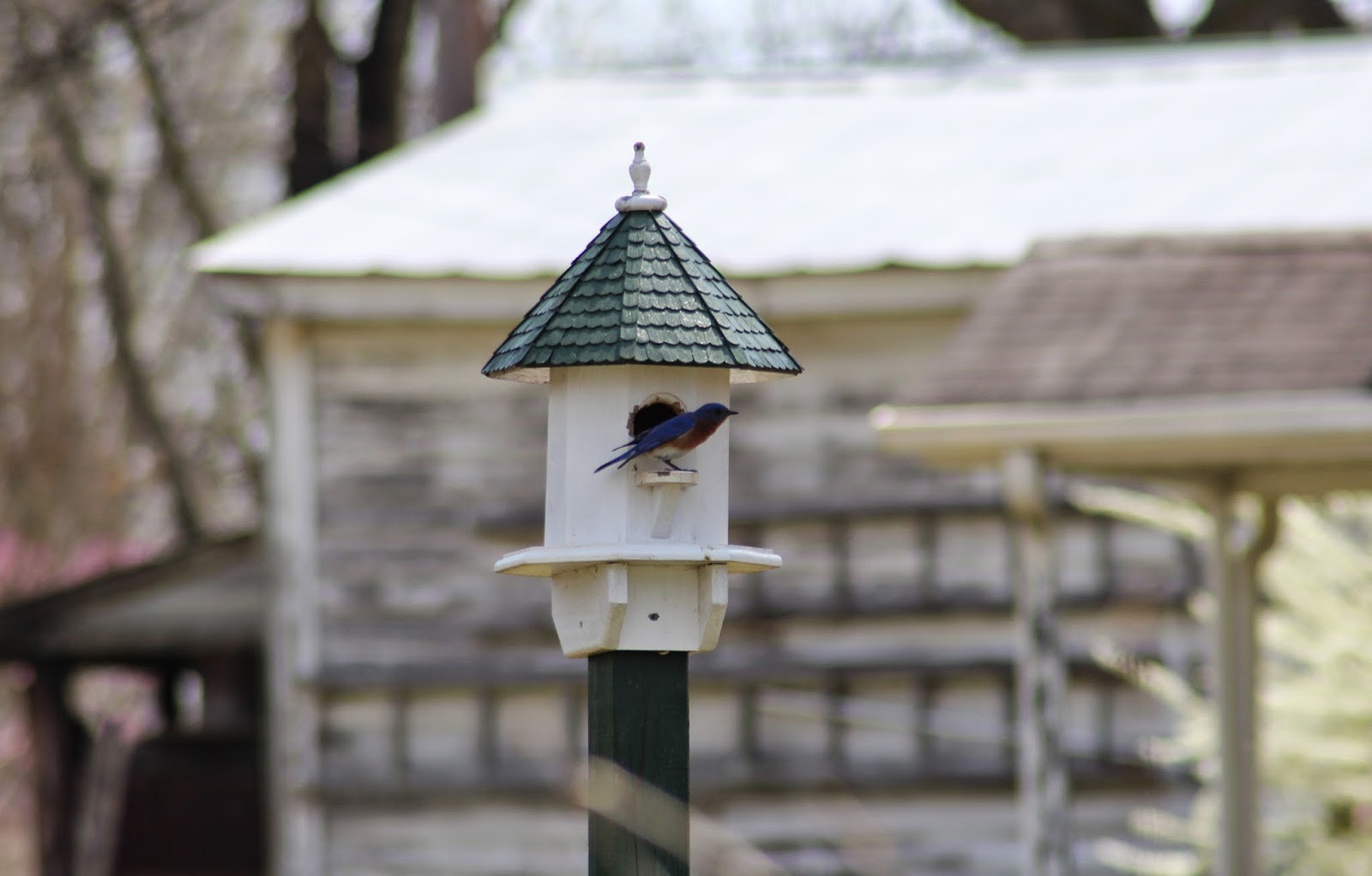ROOMS TO LET; Eastern Bluebirds Wanted
 |
| The male Eastern bluebird scouts a suitable starter home |
My tenants have returned to Traveler’s Joy. They’re highly transient, this lot, and while it may be true that beggars can’t be choosers, some of these beggars seem very picky about what’s available.
On a relatively mild day back in January I climbed on a
ladder to pull out the straw and feathers left behind in the boxes from last
season, and scrubbed the stained interiors with a solution of diluted bleach to insure that no parasites or diseases carry over.
The house sparrows that have fledged so many
generations from the small box beneath the eaves of the front porch moved back
in almost immediately.
They have also been
hanging around the free-standing birdhouse in the garden, the one that housed a
prolific pair of Eastern bluebirds when I first erected it five springs
ago. I would give anything to be able to
evict the sparrows permanently and lure the bluebirds back, since the bluebirds
are endangered natives and the house sparrows are most decidedly not. Besides that, there is no sight on earth
bound to quicken a winter-weary heart more thrillingly than the first flash of
blue wings in a bare tree.
 |
| In the new year, remove last season's nests and scrub the boxes with a solution of water & bleach, 9 to 1. |
That’s why I was delighted when I spotted a male bluebird
perched on the ledge of the birdhouse two days ago. When he showed up this
morning with his less-glamorous mate in tow, standing guard on the finial while
she sized up the digs, I allowed myself to be wildly hopeful. However, I know the odds are against them. The bluebirds are much more selective about
where they nest, and despite the fact that the free-standing box (built to
Audubon Society specifications, with a 1 ½" hole to deter larger birds) is
ideally situated a few steps away from my organic vegetable garden, which in
spring and summer abounds with berries, muscadine grapes, tomatoes, sweet
peppers and earthworms, they are deterred by the proximity of myself, my
husband and our rowdy dog Alice going to and from the front garden to the
back.
The sparrows have no such sensitivity. They are a species introduced from Europe to New York in the mid-nineteenth century, intended to control insects that preyed on local crops. Like all brilliant ideas that involve messing with a finely tuned ecosystem, this one backfired badly. The birds reproduced so rapidly in North America that they began to crowd out native species.
Their mating season
begins much earlier than most migrating natives, a fact I can attest to. I have observed pairs take up residence in my
nesting boxes as early as late January, when snow is still swirling through
town, and have watched in amazement as they proceeded to crank out one squatty
little brood of birds after another, faster than you can say Passer domesticus. Another characteristic in their favor is that
they aren’t as picky about where they live, preferring the comforting din of
nearby humans. Living so close to
people, they are less at risk of predators, unless a housecat is quick enough
to catch them. (My cat sits on the porch salivating as the birds flit back and
forth to the box and perch on the porch swing, but with one eye she rarely
manages to snag her quarry).
 |
| House sparrows favor the box on the porch. |
The sparrows have no such sensitivity. They are a species introduced from Europe to New York in the mid-nineteenth century, intended to control insects that preyed on local crops. Like all brilliant ideas that involve messing with a finely tuned ecosystem, this one backfired badly. The birds reproduced so rapidly in North America that they began to crowd out native species.
 |
| A house sparrow gets a head-start on nesting, in a February snowstorm |
For all these reasons, the house sparrows, with their ‘You snooze, you lose’ attitude, have the
Darwinian edge over the more desirable bluebirds. It’s likely that the sparrows will sneak back
into the box when the bluebirds’ backs are turned, as they have done before, and will
kick out my elegant blue tenants.
 |
| Tough little interlopers |
Meanwhile, I’ve hung the beautiful orchard mason bee-house my
husband bought me in Old Salem, facing east for the benefit of the sun's warming effect on hatching bees, as instructed. (Refer to my May 9, 2013, blog post, “Bee Aware,” for
more about this non-colonizing species of pollinators, also known as blue orchard bees.) On that side of the garden shed the rainwater
has always drained slowly, so much so during this soggy winter just past that I pulled
out what I had growing there and replaced it with a large division of Iris virginica, the native blue-flag that grows happily in standing water and very heavy clay. The iris has settled in wonderfully,
flaunting its purple-based foliage that is the hallmark of spring growth for iris descended from riverbank natives.
 |
| Nesting box for orchard mason bees |
I’m hoping that the mud and shallow water forming the iris’
habitat will help to attract the female mason bees, who collect mud and bring it
back to hollow reeds, woodpecker holes in trees, or sections of bundled bamboo
stalks, which is what my house is made of. Here they lay their young atop provisions of
nectar and pollen before sealing the eggs off in mud-walled compartments. (This is where they get their common name as ‘masons.’)
The new generation of mason bees starts hatching and emerging
from the reeds around the time the redbud blooms in the Carolinas, which is
happening right now in glorious profusion.
If I’m successful at attracting any mason bees this season, the latest
generation of pollinators should start the process of mating, laying and
sealing up their young within the next couple of weeks. I plan to keep out the welcome mat, or in their
case, the mud puddle.
 |
| The life-cycle of the mason bee is synchronized with the redbud |
I spied a brown thrasher kicking up the duff around my
raspberry canes this morning, and the red-capped woodpeckers have been
scurrying up and down the big maples in the front yard since early
February. I haven’t heard a catbird cry
yet, but it’s early still for these secretive gray migrants. They prefer the dense woods and blackberry
thickets at the edge of the meadow that borders our garden, which is also where
we watch for the young rabbits to emerge at dusk, bounding in pairs across the
uncut grass and nibbling the wild onions.
Male robins have set up camp in the big trees on our southern
boundary and are driving my husband berserk by perching on the side mirrors of
our cars and charging the rivals they see reflected in the mirrors. This form of mortal combat involves the
ejection of great quantities of liquid waste, with the ardent birds covering
our car doors in streaks of hardened ka-ka studded with feathers that has to be cleaned
off every morning before we can drive to work. I know Shakespeare wrote that “Men
are April when they woo…” but in the case of these puffed-up suitors our paint
jobs would appreciate a little less wooing and a lot more wisdom. I suppose that will come soon enough. Spring, and romance, are seasons sometimes made sweeter for being short-lived.
If you live in the Carolinas and are interested in learning
more about attracting mason bees to your garden, download the North Carolina
State University Cooperative Extension fact sheet: “How to Raise and Manage Orchard
Mason Bees for the Home Garden,” by Stephen Bambara, Extension Entomologist.



Comments
Post a Comment
Thanks for dropping by!